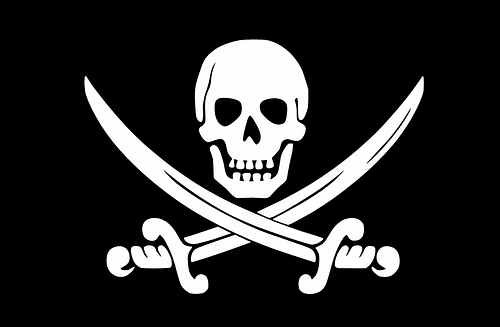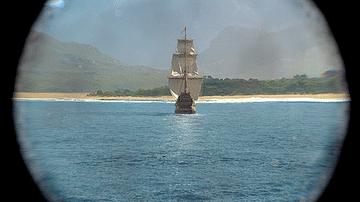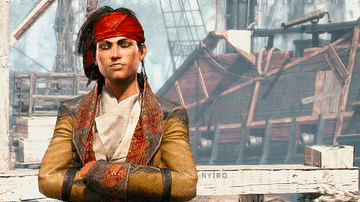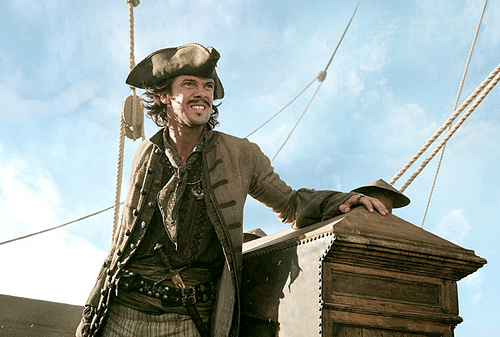
John Rackham (d. 1720), also known as Jack Rackham or 'Calico Jack' for his preference for cotton clothing, was an English pirate during the Golden Age of Piracy (1690-1730). Rackham took over the pirate crew of Charles Vane (d. 1721), and his recruits included the two infamous women pirates Anne Bonny and Mary Read. Captain Rackham was tried on four charges of piracy, found guilty, and hanged in Port Royal, Jamaica in November 1720.
Charles Vane’s Quartermaster
From at least 1718, Rackham sailed as quartermaster and the second-in-command to the notorious English pirate Charles Vane, operating in the Caribbean and off the east coast of North America. Before this time, nothing is known of Rackham's life. In August 1718, Vane refused a royal pardon in the Bahamas and fired his cannons at the ship of the governor Woodes Rogers (1679-1732) as he and Rackham escaped port and reached the freedom of the open sea.
Vane operated a small fleet of pirate ships and Rackham commanded the English prize vessel Kingston. Vane was known as a cruel pirate captain who dished out punishments such as keelhauling, and he faced accusations of not sharing out his plunder fairly amongst his crew. In November 1718, Vane refused to attack a well-armed French frigate in the Windward Passage between Cuba and Hispaniola. His crew had wanted to attack and so after a period of no prizes being taken, they eventually mutinied in the spring of 1719. On a charge of cowardice, Vane was voted out, and Rackham was promoted to captain. It may have been that the quarrel was not really about cowardice but was over Rackham not wanting to share out the liquor which was amongst the Kingston’s cargo. Vane was left to leave in another ship, but this was then shipwrecked. Vane was eventually rescued from a desert island, but he was taken to prison and hanged.
Rackham, Bonny & Read
Meanwhile, Rackham continued with his own acts of piracy. Rackham’s nickname was 'Calico Jack' because of his preference for plain 'calico' cotton (from Calcutta, India) clothes rather than the silks and velvet clothing other pirate captains preferred. Rackham’s Jolly Roger flag, used to warn victims to surrender without resistance, was unusual with two crossed cutlasses beneath a white skull on a black background.
Rackham famously had a woman pirate, Anne Bonny, in his crew. Bonny (sometimes spelt 'Bonney') was an Irish woman who had left her husband James Bonny and met Rackham in the pirate haven on Providence Island in the Bahamas around May 1719. They became lovers while Rackham was enjoying some leisure time on shore, having received a pardon from the governor, Woodes Rogers. Rackham described his approach to stealing Bonny’s heart as being no different from his strategy of capturing a vessel at sea: "no time wasted, straight up alongside, every gun brought to play, and the prize boarded" (Cordingly, 57).
Rackham then returned to piracy when he and Anne left the Bahamas in August 1719 in the William, a 12-ton single-masted sloop they had captured in the port of New Providence. The William had four large cannons, two small swivel cannons, and plenty of ammunition. On 5 September, Governor Rogers issued a warrant for the arrest of Rackham.
'Calico Jack' and Bonny, with their total crew of fewer than 20 men and a limited number of captures, were relatively small-time pirates. No large prizes were taken, and some of their victims were mere fishing boats. The booty taken was usually cargoes like tobacco, coconuts, peppers, and sugar, which were sold on to dealers in the pirate havens. At least Rackham and his crew did not have a reputation for excessive violence and mistreating their captives. A Madeira merchant ship, for example, was returned to its captain once Rackham had taken what loot he desired. Following one capture, another woman was added to the pirate crew, Mary Read. Both Bonny and Read dressed as male mariners when in battle and fought with pistols. Rackham's crew certainly made for an unusual band of renegades at a time when women at sea were a real rarity. Indeed, many pirate captains created articles that strictly prohibited women and young boys on board their ships to avoid any squabbles over sexual favours or predatory behaviour. As the historian J. Rogozinski notes, in the case of Bonny and Read, "the pirates tolerated the women because they made themselves available to everyone in Rackham’s small crew" (33).

The mixed pirate crew led by Rackham managed to temporarily evade the authorities, and they plundered the merchant ships in the waters around the Bahamas and a wide arc of shipping routes from Bermuda to Hispaniola. Bonny and Rackham had a child, but this was abandoned in Cuba where Bonny had spent the latter part of her pregnancy.
Capture
In late October or early November 1720, while anchored off the western tip of Jamaica, Rackham’s ship suffered a surprise attack from the Tyger, a 90-ton snow sent by the new governor of the island, Sir Nicholas Lawes, and commanded by Jonathan Barnet. The pirates, numbering 18, cut their anchor cable and made a hasty departure, but they were overhauled during the night and boarded. John Rackham and the rest of the crew hid below decks - they were most likely all drunk after partying with local turtle fishermen - and only Bonny, Read, and one other man put up any resistance against Barnet’s men. They were, nevertheless, captured and taken to Spanish Town (at the time called St. Jago de la Vega) on Jamaica for trial. The whole action is concisely reported by Lawes' in the following communication to London dated 13 November 1720:
About a fortnight ago a trading sloop belonging to the island being well manned and commanded by a brisk fellow, one Jonathan Barnet, did us a very good piece of service. He was met by pirate vessel at the leeward part of this island commanded by one Rackham in which were 18 pirates more whom he took and are now in gaol.
(quoted in Cordingly, 220)
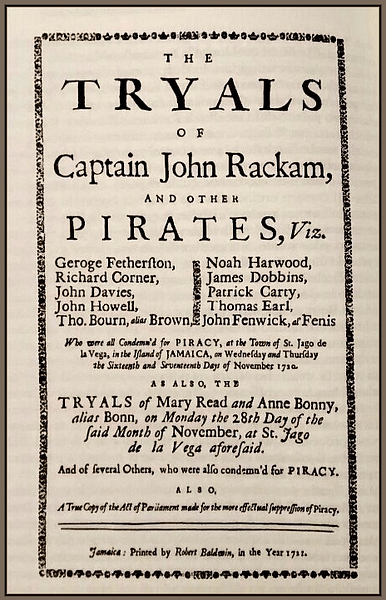
Trial & Hanging
Rackham pleaded not guilty to the charge of piracy despite the overwhelming evidence which included testimony from victims and eyewitnesses. The charges were specific to four episodes of piracy:
- That they "did practically, feloniously, and in an hostile manner, attack, engage and take, seven certain fishing boats" and that they assaulted the fishermen and stole their fish and fishing tackle.
- That they did "upon the high sea, in a certain place, distance about three leagues from the island of Hispaniola…set upon, shoot at, and take, two merchant sloops," and did assault James Dobbin and other mariners.
- That on the high sea about five leagues from Port Maria Bay in the island of Jamaica they did shoot at and take a schooner commanded by Thomas Spenlow and put Spenlow and other mariners "in corporeal fear of their lives."
- That about one league from Dry Harbour Bay, Jamaica, they did board and enter a merchant sloop called Mary, commanded by Thomas Dillon, and did steal and carry away the sloop and her tackle. (Cordingly, 63)
Rackham was found guilty of all four charges. On hearing of Rackham’s sentence of death by hanging, Bonny was unsympathetic, reportedly stating, "If you had fought like a man you wouldn’t be hanged like a dog" (Downie, 193). Rackham was hanged on 18 November and, as was customary for the most notorious pirate captains, his body was hung in a cage to rot in the open air on a small island outside Port Royal’s harbour called, appropriately enough, Deadman’s Cay (today it is called Rackham’s Cay). This gruesome spectacle was intended as a warning to others who might feel tempted to take up a life of crime. Bonny and Read were also tried a few days later and, found guilty, they were sentenced to be hanged for piracy. However, both women had their executions delayed because they revealed they were each pregnant. While Read died in prison of fever, the ultimate fate of Anne Bonny is not known.
Legacy
John Rackham was the subject of a biography alongside many other pirates in the celebrated work, the General History of the Robberies and Murders of the Most Notorious Pyrates, compiled in the 1720s. The book was credited to a Captain Charles Johnson on its title page, but this is perhaps a pseudonym of Defoe’s (although scholars are still debating the issue, and Charles Johnson may have been a real, if entirely unknown pirate expert). Given his unimpressive catalogue of mundane prizes, 'Calico Jack' would not have troubled the history books much beyond the early 18th century if it had not been for his association with Bonny and Read. One aspect of Rackham’s story, however, has proved enduringly popular, and that is his Jolly Roger pirate flag, which has been used in many contexts ever since, perhaps today most famously as the emblem of the National Football League team the Tampa Bay Buccaneers, based in Tampa, Florida.

